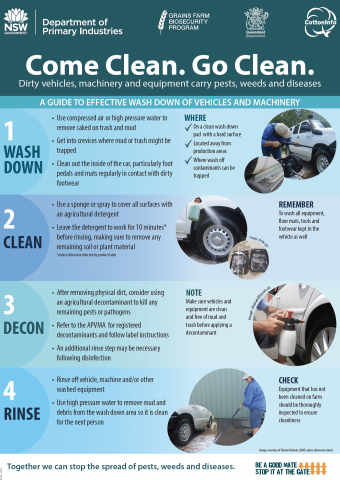Ensure all vehicles, machinery and equipment arriving onto your property are mud and trash free.
Come Clean. Go Clean is one of the simplest yet most effective ways of minimising the spread of weeds, diseases and pests. With the increased prevalence of glyphosate resistant weeds and the constant threat of pests and diseases, it is important to ensure that all machinery, vehicles and equipment arriving on and leaving farm are mud and trash free.
Mud and trash on vehicles and machinery is one of the easiest ways for weed seeds, pathogens and pests such as mealybugs spread between fields, regions and throughout the industry. Come Clean Go Clean does take commitment especially during busy and time critical periods such as picking and spraying. However, the biosecurity risks our farms, businesses and industry face are real so take the time to assess your farm’s risks.
The easiest ways to Come Clean. Go Clean are to ensure that:
- Farm operations are ordered to ensure known diseased fields are worked last or machinery is washed before moving into non-diseased fields.
- Any machinery coming from another farm is washed down before entering the farm or further fields.
- Any vehicle or equipment that is covered in mud or trash is washed down before entering the farm.
It is important to take into consideration where the machinery and vehicles have been and where they are going on farm ie. production areas or on sealed roads to ensure appropriate practices and actions are implemented which minimise the risks of weeds, diseases and pests spreading onto your farm.
How do you wash-down?
CottonInfo, NSW DPI, QLD DAF and the Grains Farm Biosecurity Program have developed a best practice 4-step wash-down guide for machinery, vehicles and equipment:
Best Practice: How to Come Clean. Go Clean in four steps:
- Wash down – with compressed air or high-pressure water to remove trash and mud.
- Clean – using a sponge or spray to cover all surfaces with an agricultural detergent.
- Decontaminate – consider using an agricultural decontaminate to kill any remaining pests or pathogens.
- Rinse – the vehicle or machine and use high-pressure water to remove mud from the wash down area.
This guide uses both an agricultural detergent and agricultural decontaminant. There are a number of products available for growers and agronomists to use to ensure vehicles, machinery and equipment are mud and trash free.
There are two different categories of wash down products available:
- Agricultural detergents/degreasers
- Agricultural decontaminants.
Agricultural detergents are used to provide optimum soil removal. While decontamination products contain actives which certain organisms and bacteria can be susceptible to. Decontaminant products also need to be applied to a surface that has all soil and trash removed to be effective.
The Cotton Pest Management Guide lists a number of agricultural detergent and decontaminant products available for growers and agronomists to use. It is important to remember to read and follow agricultural product labels carefully to ensure the suitability of use patterns as some products may be corrosive.
Resources available to help you on farm:
- Cotton Pest Management Guide – agricultural detergents and decontaminants are listed on page 124.
- Come Clean Go Clean poster – best practice 4 step wash-down guide
This blog is part of a year long program from CottonInfo, with the themes aligned with the 2020 CottonInfo cotton calendar and the UN's International Year of Plant Health. For more information, view the calendar, or contact the CottonInfo Technical Lead for Biosecurity, Sharna Holman.

